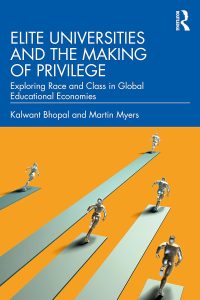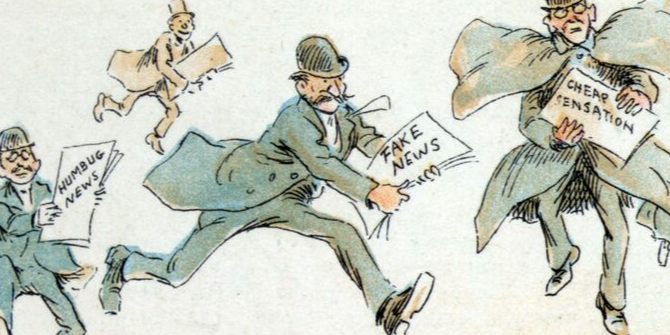In Elite Universities and The Making of Privilege: Exploring Race and Class in Global Educational Economies, Kalwant Bhopal and Martin Myers examine how elite universities uphold race- and class-based privilege. Drawing on interviews with students and Critical Race Theory, this eye-opening book exposes the extent of the inequality ingrained in the “top tier” of university education, writes Cynthia Lawson.
Elite Universities and The Making of Privilege: Exploring Race and Class in Global Educational Economies. Kalwant Bhopal and Martin Myers. Routledge. 2023.
 In Elite Universities and The Making of Privilege, Kalwant Bhopal and Martin Myers highlight the extensive role that elite universities play in maintaining the status quo. At a time where society seem to value and work toward social equality (with the upsurge in intake of students from non-traditional backgrounds such as first-generation students or students of colour), “racism”, “classism”, “elitism” and “white privilege” are terms that one might think are growing less relevant. However, the authors unveil a different picture of the realities faced by students and show how elite universities serve as a catalyst for pre-existing inequalities.
In Elite Universities and The Making of Privilege, Kalwant Bhopal and Martin Myers highlight the extensive role that elite universities play in maintaining the status quo. At a time where society seem to value and work toward social equality (with the upsurge in intake of students from non-traditional backgrounds such as first-generation students or students of colour), “racism”, “classism”, “elitism” and “white privilege” are terms that one might think are growing less relevant. However, the authors unveil a different picture of the realities faced by students and show how elite universities serve as a catalyst for pre-existing inequalities.
Racism, classism, elitism and white privilege are terms that one might think are growing less relevant. However, the authors unveil a different picture of the realities faced by students
The chapters are divided into seven different themes including eliteness, belonging, race, and global brands. Throughout the book, Bhopal and Myers draw on current debates surrounding class, race and eliteness, and the first-hand accounts of post-graduate students from various class and racial backgrounds studying at ‘elite’ universities in both the US and UK. In an environment that promotes the simple meritocratic notion of flourishing through hard work and ambition, the authors argue that elite universities serve their own interests which “tend to align with white, middle-class elites” (17).
In an environment that promotes the simple meritocratic notion of flourishing through hard work and ambition, the authors argue that elite universities serve their own interests
They begin by defining “elite” or “elitism” in the context of universities as a “readily identified institution whose prominence and status often appear … unassailable” (1). They break down the term by detailing the history of the institutions that we consider elite and how they obtained and maintain the label. The authors do emphasise the complexities attached to the term; however, power and wealth are identified as distinct features.
Cultural, social and economic capitals are contextualised within the field of education and are evidenced to have created clear pathways to success for those who possess them.
Elite Universities introduces classic theories from Pierre Bourdieu’s sociology in an attempt to understand the reproduction of status and privilege. Cultural, social and economic capitals are contextualised within the field of education and are evidenced to have created clear pathways to success for those who possess them. Students who retain these capitals have exclusive access to elite institutions and are positioned favourably on the systematic “hierarchies of privilege” (60), thus, are effortlessly able to assimilate into the elite environment. Students unaccustomed to these capitals are conscious of this. “You can see their privilege – it bleeds down – it never stops for them, they use it in every way and it starts way back from school, it just continues here”, student Kiera describes (41). The authors argue that the pathway to elite institutions is exclusive and is simply another stepping stone for elite groups to retain their power and status.
White capital is identified as a form of power within elite institutions in which ‘cultural capital finds its materialisation in practices that devalue students of colour’
Bhopal and Myers also utilise Critical Race Theory (CRT) to understand the role that race and racism play in reproducing inequalities at university level. Coupled with a Bourdiesian framework, Chapter Six, “Race, Privilege and Inequality” focuses on how race and class impact student experiences. The chapter heavily relies upon interview extracts from student narratives which detail the unique perceptions of how racism operates within their respective universities. White capital is identified as a form of power within elite institutions in which “cultural capital finds its materialisation in practices that devalue students of colour” (107). The authors identified a “hierarchy of oppression” where the “disadvantage of race intersects with class identity” (81). The exclusive social and cultural capitals are used to adapt to the environment and thus view their environment from a racially colourblind lens, where racism is not as prevalent in their experience. On the other hand, students of colour who are less privileged shared a common experience of racism as they do not share this cultural capital, and thus feel the need to change their behaviour to either blend in or exclude themselves from social spaces altogether. The contrast in experiences detailed within the responses amongst students of colour highlights the importance of intersectionality and the inequalities and privileges that come with it.
The ‘brand’ and global reputation of elite universities are significant in legitimising authority and prove to be compelling factors for students in the decision to attend such university.
Another of the book’s main themes is global brands. The “brand” and global reputation of elite universities are significant in legitimising authority and prove to be compelling factors for students in the decision to attend such university. Bhopal and Myers evidence an apparent link between elite universities and elite groups particularly within politics and the media. The authors argue that the brand gives a means to extend their power through knowledge production which is shared exclusively with its students. Inherent inequalities of race and class are “regulated and transmitted generationally within the brand” (121) and this is significant in maintaining the status quo. Ultimately, Bhopal and Myers argue that inequalities are an overt and distinct feature of elite universities that are not coincidental or a by-product of the university’s history. Rather, it is an imperative feature to maintain the interests of both academic and non-academic elites. Bhopal and Myers argue that the global identities that these institutions form are used as a way to legitimise their authority on a global scale.
As a scholar centring my research on students’ racial experiences in higher education, Elite Universities and The Making of Privilege provides an intellectual foundation for understanding the formation, maintenance and impact of elite universities. Although there are chapters that may be difficult to interpret for first-time readers of particular topics, such as those on global brands and educational economy, Bhopal and Myers use modern examples such as Nike to articulate their argument, a tangible comparison that makes these ideas easier to comprehend. The empirical evidence integrated throughout the book produces a solid grounding for further research into mitigating inequalities in education and emphasises how race is fixed within the essence of eliteness.
Bhopal and Myers make great use of student voices to bring insight into the true experiences of applying to and attending elite institutions.
Bhopal and Myers make great use of student voices to bring insight into the true experiences of applying to and attending elite institutions. Albeit a controversial topic given that universities claim to operate as meritocracies, the experiences of students cannot be denied or ignored and are suitably used as evidence to corroborate the authors’ conclusions. Elite Universities does a brilliant job of highlighting the mirrored issues between elite UK and US universities that are deeply ingrained in these institutions, and showcases how the different intersections of one’s identity can yield multiple types of experiences. It is a valuable resource for anyone wanting to gain not only a greater understanding of the inner workings of elite universities and the role they play in reproducing inequalities, but also of how race and class affect students studying at elite universities.
- Read an excerpt from Elite Universities and The Making of Privilege by Kalwant Bhopal and Martin Myers on the LSE Higher Education Blog.
- Image Credit: James Jiao on Shutterstock.
- This review first appeared at LSE Review of Books.
- Please read our comments policy before commenting.
- Note: This article gives the views of the author, and not the position of USAPP – American Politics and Policy, nor of the London School of Economics.
- Shortened URL for this post: https://bit.ly/3LpHqyT






